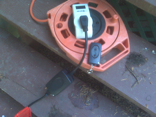Template:Statusboxtop Template:Status-Design Template:Status-Prototype You can help Appropedia by contributing to the next step in this OSAT's Category:Status Template:Boxbottom
Abstract
This device is meant to be a simple addition to a dwelling with a pre-installed eavestrough and gutter system. The system consists of a barrel and a small pump to allow for water to be distributed in a yard for irrigation purposes. This type of system should not be used for drinking water. The system will collect water from the eavestrough until the tank fills, extra water will leave through overflow valve.
The pump in the system runs on 120 volt outlet and connects to a standard garden hose. Water can be distributed around the yard with the higher points in the yard receiving a lower flow rate due to the difference in hydrostatic head pressure.
The system was designed to be used in conjunction with a existing source of water and a need/want for irrigation. The goal of this system is to reduce water consumption and raise awareness about water use.
Theory
Rain Water Capture
We can calculate the maximum amount of water that can be captured in your area using the following formula:
V = R*CR*A
Where V is volume in m3, R is annual rainfall, CR is water loss coefficient, and A is capture area. The annual rainfall can be found from climate websites and government information for specific area. The water loss coefficient accounts for losses due to evaporation, minor roof infiltration and overflow of the roof gutters typically 0.8.
Hydrostatic head exists in systems where there is a difference in height between the source and point of distribution. The higher the distribution point is then the storage point the more power required for the same resulting flow/pressure and vise versa. Friction exists in pipe/hose flow, this reduces the power at the distribution point for longer length or higher friction pipes.
Regional Considerations
This system is be used solely for irrigation where domestic water is always available. Neither a first flush or water filtration system has been used in this system.
Materials used in experimental system
- Roof of approximately ~1200 sqft
- Located in Invermere B.C.
- Fitted with standard aluminum gutters and downspout
- Standard plastic barrel (~159L). ($100)[1]
- Fitted with a spout on the top and bottom
- Top is left open for overflow
- Barrel must be placed on sturdy pad so that it doesn’t move or sink when area becomes wet
- Pump: Ridgid 1/6 HP Submersible Utility Pump ($80) Heavy version available ($214) [2]
- 50' garden hose extension ($10)
- wire mesh ($10)
Tools Needed
- Hack saw (or serrated knife)
- Wire cutters
Device Construction
To assemble the device:
Testing results
The original flow from the barrel:
Flow = 1.72 L/min
Flow with pump through full hose with -0.5m of head.
Flow = 9.09L/min
Flow with pump through full hose while walking around the whole yard with +2 m to -2 m of head. Whole barrel was emptied in 17:35 mins.
Flow = 9.07 L/min
While running through full hose with maybe 1m head. Measured using a Home Hardware watt meter.
Voltage = 119V
Current = 1.39 +/- 0.09 amps
Power factor = 0.96
Power = 164 +/- 5 watts
Energy consumption for distributing one barrel.
Energy = 0.0474 kWhr
The cost of distributing one barrel of water can be found using the price of electricity in Ontario from Hydro One of $0.066/kWh.
Price = $0.0031/barrel Price = $0.019/m3
This price of water in Ontario for example from Kingston Utilities is $0.878/m3 which includes the pressure to distribute the water in your yard. While the water price from rainwater is much cheaper it would require filling and draining the barrel 1465 times before you recovered the upfront costs, not accounting for the time value of money, losses or any maintenance.
Discussion
Downfalls
- This device is not meant for drinking water
- Limited storage capacity
- The device is not stand alone and must only be used to help reduce water usage of current system
- Opaque plastic barrel started to grow algae on the inside
- Contaminants from collection system went straight into barrel
- Requires pump and therefore electricity
- Not very economical
- Overflow rate more then one spout can handle leading to uncontrolled overflow and erosion of barrel support structure
- Relied on existing gutter and capture system
Lessons learned for developing world application
- Use storage container that is impenetrable to light to prevent growth of algae
- Simple debris filter would eliminate many contaminates
- Create better system for overflow to prevent overflow and possible distribute to somewhere useful
- Carefully plan locations for storage container to take advantage of hydrostatic head pressure and avoid need for pump
- Ensure to account for the differences in capture system due to differing weather patterns in other parts of the world.
References
- ↑ Home depot http://www.homedepot.ca/webapp/wcs/stores/servlet/CatalogSearchResultView?D=916213&Ntt=916213&catalogId=10051&langId=-15&storeId=10051&Dx=mode+matchallpartial&Ntx=mode+matchall&recN=0&N=0&Ntk=P_PartNumber
- ↑ Home Depot http://www.homedepot.ca/webapp/wcs/stores/servlet/CatalogSearchResultView?D=940888&Ntt=940888&catalogId=10051&langId=-15&storeId=10051&Dx=mode+matchallpartial&Ntx=mode+matchall&recN=0&N=0&Ntk=P_PartNumber
